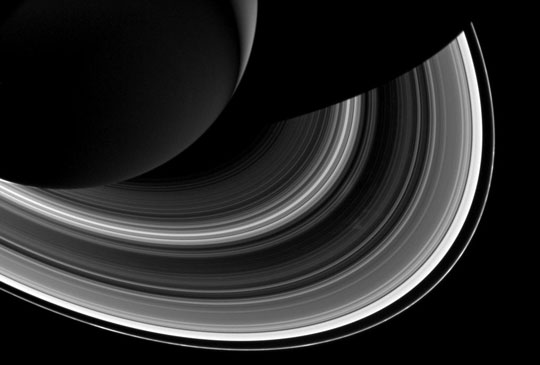Saturn’s F Ring Gives Birth To Short-Lived Moons
This article is more than 2 years old
 Saturn made news a few months ago when astronomers spotted what they believed was a new moon being born in the planet’s A Ring. As it turns out, the event was rare not because it featured the birth of a new moon, but because of its placement. Saturn’s F Ring, it’s outermost one, gives birth to moons fairly regularly, but those events are easy to miss because the moons die almost as quickly they appear.
Saturn made news a few months ago when astronomers spotted what they believed was a new moon being born in the planet’s A Ring. As it turns out, the event was rare not because it featured the birth of a new moon, but because of its placement. Saturn’s F Ring, it’s outermost one, gives birth to moons fairly regularly, but those events are easy to miss because the moons die almost as quickly they appear.
To look at, the F Ring isn’t as bright as most of the inner ones, it’s made of chunky ice and is thinner than the others. But it does illustrate a principle called the Roche limit, which is the boundary beyond which moons can form and stay intact. Inside the Roche limit, gravity pulls at the newly formed moons on opposite sides with such force that it can tear them apart, particularly when they’re not particularly massive.

So what’s changed since then? In a recent article published in Icarus, scientists argue that the birth and death of the F Ring moons depends on the positions of two nearby moons, Prometheus and Pandora. These two are called shepherd moons because they help keep an body—in this case, the F Ring—intact. Prometheus, which has a diameter of about 53 miles, orbits inside the ring while Pandora, which has a diameter of roughly 50 miles, orbits outside it. The constant push and pull of their gravitational fields keeps the F Ring intact.
Every 17 years, Prometheus enters into a specific alignment with the F Ring where it has a greater pull than Pandora does, and scientists believe that that extra force is what prompts the ring into producing so many mini-moons, or “moonlets.”
Such observations provide insight into how other moons, as well as the entire solar system, were formed. Astronomers note that these processes have been in place for billions of years and can provide a model for how the universe may have behaved right after the big bang.












